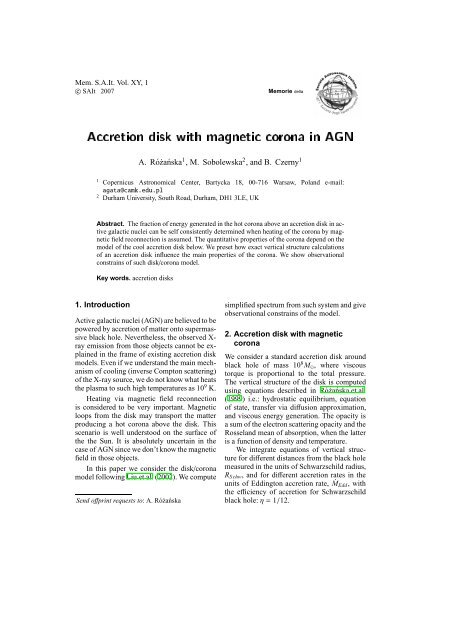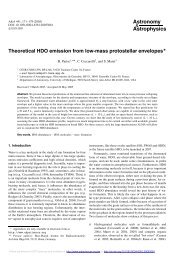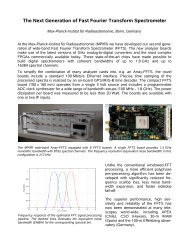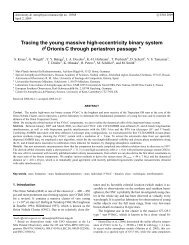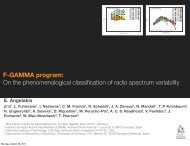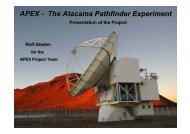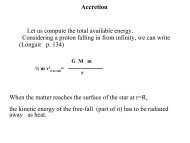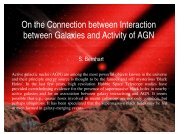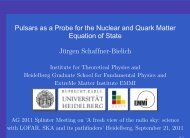Accretion disk with magnetic coronae in AGN
Accretion disk with magnetic coronae in AGN
Accretion disk with magnetic coronae in AGN
You also want an ePaper? Increase the reach of your titles
YUMPU automatically turns print PDFs into web optimized ePapers that Google loves.
ÖØÓÒ×ÛØÑÒØÓÖÓÒÒÆ<br />
A. Różańska 1 , M. Sobolewska 2 , and B. Czerny 1<br />
Mem. S.A.It. Vol. XY, 1<br />
c○ SAIt 2007 Memorie della<br />
1 Copernicus Astronomical Center, Bartycka 18, 00-716 Warsaw, Poland e-mail:<br />
agata@camk.edu.pl<br />
2 Durham University, South Road, Durham, DH1 3LE, UK<br />
Abstract. The fraction of energy generated <strong>in</strong> the hot corona above an accretion <strong>disk</strong> <strong>in</strong> active<br />
galactic nuclei can be self consistently determ<strong>in</strong>ed when heat<strong>in</strong>g of the corona by <strong>magnetic</strong><br />
field reconnection is assumed. The quantitative properties of the corona depend on the<br />
model of the cool accretion <strong>disk</strong> below. We preset how exact vertical structure calculations<br />
of an accretion <strong>disk</strong> <strong>in</strong>fluence the ma<strong>in</strong> properties of the corona. We show observational<br />
constra<strong>in</strong>s of such <strong>disk</strong>/corona model.<br />
Key words. accretion <strong>disk</strong>s<br />
1. Introduction<br />
Active galactic nuclei (<strong>AGN</strong>) are believed to be<br />
powered by accretion of matter onto supermassive<br />
black hole. Nevertheless, the observed X-<br />
ray emission from those objects cannot be expla<strong>in</strong>ed<br />
<strong>in</strong> the frame of exist<strong>in</strong>g accretion <strong>disk</strong><br />
models. Even if we understand the ma<strong>in</strong> mechanism<br />
of cool<strong>in</strong>g (<strong>in</strong>verse Compton scatter<strong>in</strong>g)<br />
of the X-ray source, we do not know what heats<br />
the plasma to such high temperatures as 10 9 K.<br />
Heat<strong>in</strong>g via <strong>magnetic</strong> field reconnection<br />
is considered to be very important. Magnetic<br />
loops from the <strong>disk</strong> may transport the matter<br />
produc<strong>in</strong>g a hot corona above the <strong>disk</strong>. This<br />
scenario is well understood on the surface of<br />
the the Sun. It is absolutely uncerta<strong>in</strong> <strong>in</strong> the<br />
case of <strong>AGN</strong> s<strong>in</strong>ce we don’t know the <strong>magnetic</strong><br />
field <strong>in</strong> those objects.<br />
In this paper we consider the <strong>disk</strong>/corona<br />
model follow<strong>in</strong>g Liu et al. (2002). We compute<br />
Send offpr<strong>in</strong>t requests to: A. Różańska<br />
simplified spectrum from such system and give<br />
observational constra<strong>in</strong>s of the model.<br />
2. <strong>Accretion</strong> <strong>disk</strong> <strong>with</strong> <strong>magnetic</strong><br />
corona<br />
We consider a standard accretion <strong>disk</strong> around<br />
black hole of mass 10 8 M ⊙ , where viscous<br />
torque is proportional to the total pressure.<br />
The vertical structure of the <strong>disk</strong> is computed<br />
us<strong>in</strong>g equations described <strong>in</strong> Różańska et al.<br />
(1999) i.e.: hydrostatic equilibrium, equation<br />
of state, transfer via diffusion approximation,<br />
and viscous energy generation. The opacity is<br />
a sum of the electron scatter<strong>in</strong>g opacity and the<br />
Rosseland mean of absorption, when the latter<br />
is a function of density and temperature.<br />
We <strong>in</strong>tegrate equations of vertical structure<br />
for different distances from the black hole<br />
measured <strong>in</strong> the units of Schwarzschild radius,<br />
R S chw , and for different accretion rates <strong>in</strong> the<br />
units of Edd<strong>in</strong>gton accretion rate, Ṁ Edd , <strong>with</strong><br />
the efficiency of accretion for Schwarzschild<br />
black hole:η=1/12.
2 Różańska et al.: Magnetic corona <strong>in</strong> <strong>AGN</strong><br />
The <strong>magnetic</strong>ally heated corona above an<br />
accretion <strong>disk</strong> is assumed to be <strong>in</strong> equipartition<br />
<strong>with</strong> the gas energy of the <strong>disk</strong> Liu et al.<br />
(2002). The hot corona is <strong>in</strong> thermal equilibrium,<br />
which means that heat<strong>in</strong>g via <strong>magnetic</strong><br />
field is balanced by cool<strong>in</strong>g via Compton scatter<strong>in</strong>g<br />
of both: the <strong>in</strong>tr<strong>in</strong>sic <strong>disk</strong> photons and<br />
the reprocessed radiation. The size of <strong>magnetic</strong><br />
loop is assumed to be constant and equal to<br />
10 R S chw Averaged density of the evaporat<strong>in</strong>g<br />
plasma is estimated from the energy balance at<br />
the <strong>disk</strong>/corona <strong>in</strong>terface.<br />
The coronal temperature, T, and the coronal<br />
density, n are calculated <strong>in</strong> the follow<strong>in</strong>g<br />
steps: i) for the given R and Ṁ we calculate<br />
the <strong>disk</strong> structure, ii) know<strong>in</strong>g P gas at the equatorial<br />
plane of the <strong>disk</strong> we derive strength of<br />
<strong>magnetic</strong> field B, iii) for the given B, and soft<br />
photons flux, F so f t , and from the conditions of<br />
energy equilibrium <strong>in</strong> the corona and at the<br />
<strong>disk</strong>/corona <strong>in</strong>terface, we calculate temperature<br />
and density.<br />
Such a solution depends on the fraction of<br />
the accretion energy dissipated <strong>in</strong> the corona,<br />
f cor , and <strong>in</strong>versely, there is a back reaction:<br />
the energy transfered from the <strong>disk</strong> to the<br />
corona by <strong>magnetic</strong> reconnection affects the<br />
<strong>disk</strong> structure.<br />
It was shown by Liu et al. (2002) that the<br />
ratio of energy dissipated <strong>in</strong> the corona to the<br />
total energy generated via accretion is proportional<br />
to the strength of <strong>magnetic</strong> field and<br />
Alfven speed:<br />
f cor = B2<br />
4π V A<br />
[ ( 3GMṀ<br />
1−<br />
8πR 3<br />
( RS<br />
) 1/2<br />
)] −1<br />
chw<br />
. (1)<br />
R<br />
The fraction of coronal energy is self consistently<br />
calculated by iteration of Eq.1 and solution<br />
of the <strong>disk</strong> structure. Note, that <strong>in</strong> the<br />
<strong>magnetic</strong> loops model only 1− f cor fraction of<br />
total angular momentum is carried by a <strong>disk</strong>.<br />
Contrarily to the accret<strong>in</strong>g corona model, <strong>magnetic</strong><br />
loops do not expla<strong>in</strong> how the fraction f cor<br />
of angular momentum is transfered outward.<br />
In case of <strong>magnetic</strong> loops, angular momentum<br />
transfer could be possible only when we additionally<br />
assume the existence of <strong>magnetic</strong>ally<br />
driven w<strong>in</strong>ds.<br />
Full results of those computations are presented<br />
<strong>in</strong> Różańska & Czerny (2005). For wide<br />
range of accretion rates <strong>disk</strong>s are dom<strong>in</strong>ated<br />
by radiation pressure, which is <strong>in</strong> contradiction<br />
<strong>with</strong> the analytical solution presented by<br />
Liu et al. (2002). In both considered cases i.e.:<br />
for Ṁ= 0.5Ṁ Edd and Ṁ=0.1Ṁ Edd , self consistent<br />
determ<strong>in</strong>ation of f cor is possible only<br />
for specific range of distances from the black<br />
hole (see: Fig. 2 and 3 <strong>in</strong> Różańska & Czerny<br />
(2005)). For the case of Ṁ= 0.5Ṁ Edd , corona<br />
extends up to 55 R S chw , for the Ṁ= 0.1Ṁ Edd ,<br />
up to 13 R S chw .<br />
3. Total spectrum from an accretion<br />
<strong>disk</strong> <strong>with</strong> <strong>magnetic</strong> corona<br />
The best test for our model is to calculate<br />
the total spectrum form an accretion<br />
<strong>disk</strong>/corona system which we present <strong>in</strong><br />
Fig.1. On each radius we assumed, follow<strong>in</strong>g<br />
Haardt & Maraschi (1991), than only half<br />
of radiation from corona is emitted as X-ray<br />
power-law. The second half illum<strong>in</strong>ates the<br />
<strong>disk</strong> and it is reprocessed and reemitted <strong>with</strong><br />
soft <strong>disk</strong> radiation. Compton amplification factor,<br />
A, for each radius depends only on the<br />
f cor , and <strong>disk</strong> albedo is assumed to be 0.15<br />
(Haardt & Maraschi 1991).<br />
The photon <strong>in</strong>dex on each radius is computed<br />
form Beloborodov (1999), us<strong>in</strong>g formula<br />
Γ= 7 3 (A−1)−1/10 . (2)<br />
The total spectrum is computed by <strong>in</strong>tegrat<strong>in</strong>g<br />
over <strong>disk</strong> radius: black body emission, from 3<br />
up to 10 5 R S chw , and corona power-law emission<br />
from 3 up to the extension of the corona.<br />
For both accretion rates we calculate the<br />
average ratio of X-ray to optical lum<strong>in</strong>osity<br />
(Zamorani et al. 1981), def<strong>in</strong>ed as:<br />
α ox = − log(l 2keV/l 2500Å )<br />
, (3)<br />
2.605<br />
where 2.605=log(ν 2keV /ν 2500Å ). For our models<br />
this <strong>in</strong>dex equals 1.99 for Ṁ = 0.5Ṁ Edd ,<br />
and 1.74 for Ṁ = 0.1Ṁ Edd . Typical observational<br />
values ofα ox for quasars span from 0.1<br />
up to 2 (Bechtold et al. 2003).
Różańska et al.: Magnetic corona <strong>in</strong> <strong>AGN</strong> 3<br />
45<br />
44<br />
43<br />
42<br />
41<br />
40<br />
14 16 18 20<br />
Fig. 1. Total spectrum from the <strong>disk</strong> corona system for accretion rate 0.5 -dashed l<strong>in</strong>e, and for 0.1 - solid<br />
l<strong>in</strong>e. Blue l<strong>in</strong>es represent <strong>disk</strong> black body spectra, red l<strong>in</strong>es represent power-law from <strong>coronae</strong>, and black<br />
l<strong>in</strong>es are total spectra for both cases. For higher accretion rate corona is weaker, but more extended.<br />
4. Conclusions<br />
We have calculated the radial structure of the<br />
<strong>magnetic</strong> corona above a vertically <strong>in</strong>tegrated<br />
accretion <strong>disk</strong>. Our model is parameterized<br />
only by global parameters: mass of the black<br />
hole and total accretion rate. For higher accretion<br />
rates the corona is weaker, but more extended.<br />
We have calculatedα ox <strong>in</strong>dex correspond<strong>in</strong>g<br />
to the average ratio of X-ray to optical lum<strong>in</strong>osity.<br />
For higher accretion rate this <strong>in</strong>dex<br />
is higher. Ourα ox <strong>in</strong>dices do agree <strong>with</strong> observed<br />
<strong>in</strong>dices of high redshift quasars shown<br />
by Bechtold et al. (2003), and Strateva et al.<br />
(2005), but do not agree <strong>with</strong> those of Seyfert<br />
1 galaxies (Strateva et al. 2005).<br />
Acknowledgements. This work was supported by<br />
grant 1P03D00829 of the Polish State Committee<br />
for Scientific Research.<br />
References<br />
Bechtold, J., Siemig<strong>in</strong>owska, A., Shields, J.,<br />
et al. 2003, ApJ, 588, 119<br />
Beloborodov, A. M. 1999, <strong>in</strong> ASP Conf. Ser.<br />
161: High Energy Processes <strong>in</strong> Accret<strong>in</strong>g<br />
Black Holes, ed. J. Poutanen & R. Svensson,<br />
295<br />
Haardt, F. & Maraschi, L. 1991, ApJ, 380, L51<br />
Liu, B. F., M<strong>in</strong>eshige, S., & Shibata, K. 2002,<br />
ApJ, 572, L173<br />
Różańska, A. & Czerny, B. 2005, <strong>in</strong> AIP Conf.<br />
Proc. 801: Astrophysical Sources of High<br />
Energy Particles and Radiation, ed. T. Bulik,<br />
B. Rudak, & G. Madejski, 399–402<br />
Różańska, A., Czerny, B., Życki, P. T., &<br />
Pojmański, G. 1999, MNRAS, 305, 481<br />
Strateva, I. V., et al. 2005, AJ, 130, 387<br />
Zamorani, G., Henry, J. P., Maccacaro, T., et al.<br />
1981, ApJ, 245, 357


